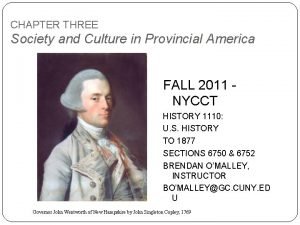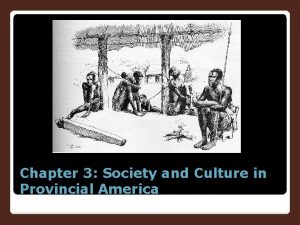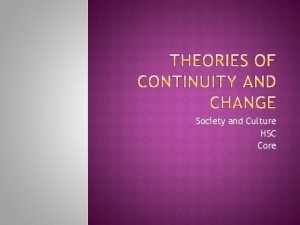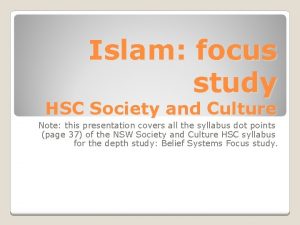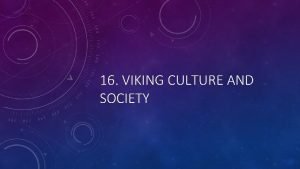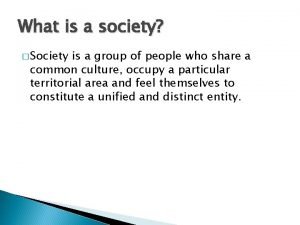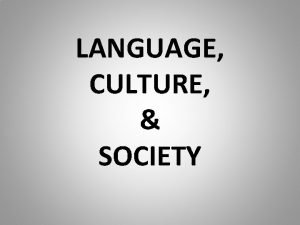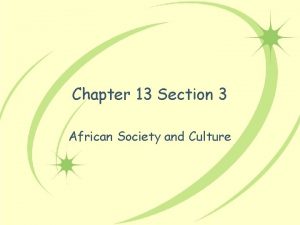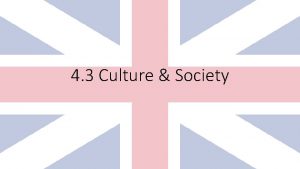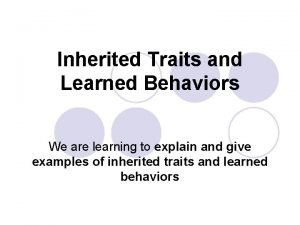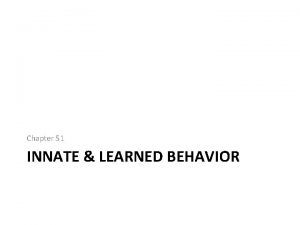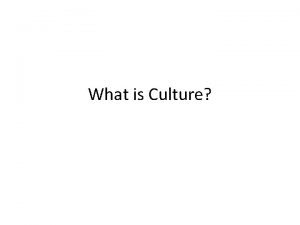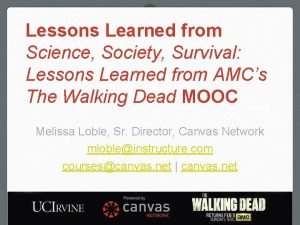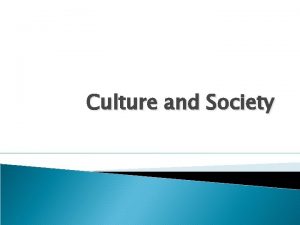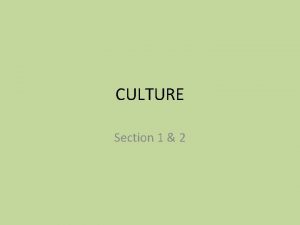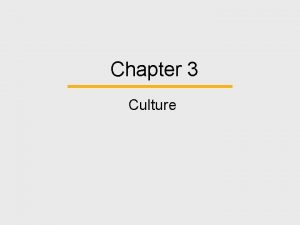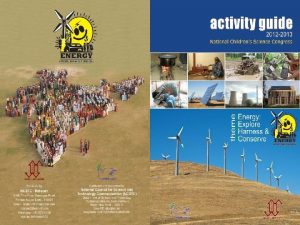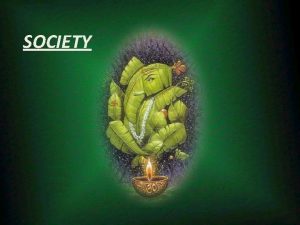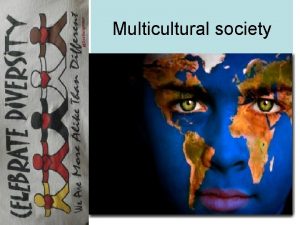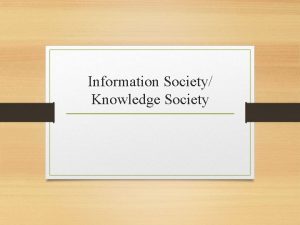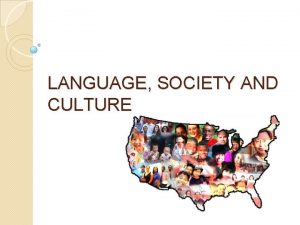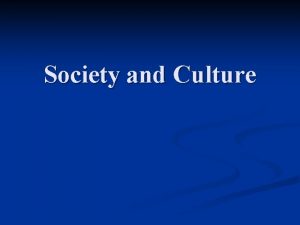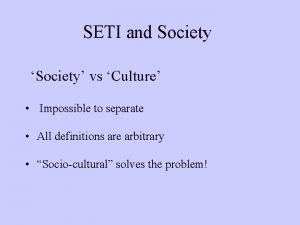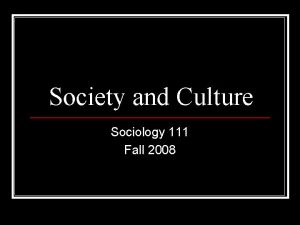CULTURE Chapter 3 Culture and Society Culturethe learned































- Slides: 31

CULTURE Chapter 3

Culture and Society • Culture—the learned and shared behaviors, beliefs, attitudes, values, and material objects that characterize a particular group or society • Society—a group of people that has lived and worked together long enough to become an organized population and to think of themselves as a social unit

Characteristics of Culture • • Culture is learned. Culture is transmitted from one generation to the next. Culture is shared. Culture is adaptive and always changing.

Material and Nonmaterial Culture • Material culture consists of the tangible objects that members of a society make, use, and share. – Examples include tools, jewelry, pottery, clothing, and furniture. • Nonmaterial culture includes the shared set of meanings that people use to interpret and understand the world. – Examples include political opinions, religious beliefs, and marriage patterns.

Application What are the material and nonmaterial cultures of …? • Football • School • Eating in a restaurant

Symbols • Symbol—anything that stands for something else and has a particular meaning for people who share a culture • Symbols take many forms: – Words—chair, tomorrow, hope – Gestures—wave, salute – Visual images—tattoos, logos – Physical objects—cross or wedding ring

Symbols • Symbols distinguish one culture from another. • Veil may be a symbol of respect or domination. • Symbols can unify or divide a society. • Confederate flag is a source of pride or offense. • Symbols can change over time. • “Green” is now used to mean environmentally responsible.

Language • Language is a system of shared symbols that enables people to communicate with one another. • Language is important. – It makes us human. – It helps us interact. – It directs our thinking, controls our actions, and gives us a sense of belonging.

Gender, Race, and Ethnicity • Language influences how we perceive genders, races, and ethnicities. • Words create and reinforce both positive and negative images.

Something to consider: • Is it acceptable to use racist or sexist terms to describe oneself or one’s group? • Is there anything wrong with the traditional use of language such as businessman, chairman, mailman, or mankind? • Is it acceptable to use he to refer to individuals who may be male or female?

Values • Values are the standards by which members of a particular culture define what is good or bad, moral or immoral, proper or improper, desirable or undesirable, beautiful or ugly. • Major U. S. values include achievement and success, activity and work, morality, humanitarianism, efficiency, equality, and individuality.

Values • Major U. S. values include: 1. Achievement and success 2. Activity and work 3. Morality 4. Humanitarianism 5. Efficiency 6. Equality 7. Individuality.

Norms • Norms are society’s specific rules of right and wrong behavior. • Norms tell us what we should or should not do.

Characteristics of Norms • • • Most are unwritten. They are instrumental. Some are explicit while others are implicit. They change over time. Most are conditional. Norms can be rigid or flexible.

Three Types of Norms • Folkways: norms that members of a society look upon as not being critical and that may be broken without severe punishment • Mores: norms that society considers very important because they maintain morals and ethics • Laws: norms that are defined and enforced by a political authority

Sanctions • Sanctions—rewards for appropriate behavior and penalties for inappropriate behavior • Sanctions vary in strength and can be positive or negative. • A hug • A prison term • Getting fired

SOME CULTURAL SIMILARITIES

Cultural Similarities • Cultural universals—customs and practices that are common to all societies. • All cultures include bodily adornments, dancing, food taboos, ideas about modesty, and expectations for mourning. • Cultures differ in the expressions of the universals.

Ideal Versus Real Culture • Ideal culture—the beliefs, values, and norms that people say they hold • Real culture—actual everyday behavior – Example: Many people exceed the speed limit.

Attitudes about Cultures • Ethnocentrism is the belief that one’s culture and way of life are superior to those of another group. • Cultural relativism involves recognizing that no culture is better than another and that a culture should be judged by its own standards.

Subcultures • A subculture is a group or category of people whose distinctive ways of thinking, feeling, and acting differ somewhat from those of the larger society. • Subcultures can be based on ethnicity, religion, politics, age, physical disability, or social class.

Countercultures • Countercultures can range from the Ku Klux Klan to the Older Order Amish.

Multiculturalism • Multiculturalism refers to the coexistence of many cultures in the same geographic area, without any one culture dominating another. • Multiculturalism is also called cultural pluralism.

Culture Shock • Culture shock is a sense of confusion, uncertainty, disorientation, or anxiety that accompanies exposure to an unfamiliar environment. • We react to differences in personal hygiene, privacy, food, and personal space.

POPULAR CULTURE • Popular culture refers to the beliefs, practices, activities, and products that are widely shared among a population in everyday life. • It includes television, music, magazines, radio, advertising, sports, fashions, movies, and food.

Cultural Imperialism • Cultural imperialism involves the cultural values and products of one society influencing or dominating another society. • American fast food restaurants, toys, music, and advertising are available in most countries of the world.

Cultural Persistence • Culture is transmitted to new generations. • New behaviors and beliefs adapt to existing ones through cultural integration. • Life would be chaotic and unpredictable without cultural integration. • Cultural and Technology: Culture is both stable and dynamic.

Cultural Dynamics • Diffusion—the process through which components of culture spread from one society to another – Internet is available throughout the world. • Invention—the process of creating new things – DVDs were invented in 1995.

Cultural Dynamics • Innovation—turning inventions into massmarket products – Henry Ford began mass producing automobiles. • Discovery—exploration that results in new products – Penicillin prolongs lives.

Cultural Lag Cultural lag refers to the gap when nonmaterial culture changes more slowly than material culture. • Cell phones were invented before our norms for when to use them. • Reproductive technologies are available but there is still confusion about the moral issues.

Sociological Perspectives on Culture • Functionalists focus on culture as a cement that binds society. • Conflict theorists argue that culture can generate enormous inequality. • Feminist scholars focus on gender differences. • Interactionists study how people interpret and transmit culture.
 Society and culture in provincial america
Society and culture in provincial america Chapter 3 society and culture in provincial america
Chapter 3 society and culture in provincial america Gertler econ
Gertler econ Hsc society and culture
Hsc society and culture Hsc society and culture
Hsc society and culture Conclusion for project
Conclusion for project Culture and society are intricately related
Culture and society are intricately related Viking society and culture
Viking society and culture Vce chinese language culture and society
Vce chinese language culture and society Relationship between society and culture
Relationship between society and culture Relationship between society and culture
Relationship between society and culture West african society and culture section 3
West african society and culture section 3 Southern colonies society/culture
Southern colonies society/culture Cultural relativism
Cultural relativism Batch culture vs continuous culture
Batch culture vs continuous culture American culture vs indian culture
American culture vs indian culture Stab culture and stroke culture
Stab culture and stroke culture Folk culture and popular culture venn diagram
Folk culture and popular culture venn diagram Folk cultures are spread primarily by
Folk cultures are spread primarily by Anerobic media
Anerobic media Homework due today
Homework due today Stab culture and stroke culture
Stab culture and stroke culture Carpet culture microbiology
Carpet culture microbiology Surface culture deep culture and esol
Surface culture deep culture and esol Difference between innate and learned behavior
Difference between innate and learned behavior Example of learned behavior
Example of learned behavior Active artificial immunity
Active artificial immunity Innate and learned behavior
Innate and learned behavior Keywords for cause and effect
Keywords for cause and effect Kinesis and taxis
Kinesis and taxis Learned vs innate behavior
Learned vs innate behavior Safety is a learned behavior and attitude
Safety is a learned behavior and attitude
